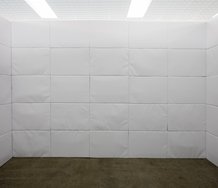Luke Munn – 20 May, 2013
'On Off Moments' is characterised by a group of artists steeped in a kind of technological mediation, an assumed, instilled ubiquity. Rather than operating as either technofetishistic or phobic, the relationship could be best described as collaborative, each artist working with or playing with media as a counterpart to their own contribution.
Berlin
David Horvitz, Daniel Kötter, Mikka Wellner, Murat Adash, Laura McLardy, Gretta Louw, David Kroell
On Off Moments
Curated by Amelie Wedel
May 10 - June 9, 2013
On April 12th, 2012 Paul Miller left the internet. The senior editor of tech site The Verge, who regularly spent over 12 hours a day online, pulled the plug at midnight after a timed countdown. A recent video review captures the highlights (or lack thereof) during the self-imposed netless year (1). While Miller seems to cope easily with the move from GPS enabled smartphones to paper maps, or using public libraries in place of Wikipedia for information, the meaningful experiences so often promised with the ‘unplugging’ process never eventuate. In contrast, this immediacy seems to accentuate problems: rather than multiple selves distributed across a range of social and gaming networks, there was only a single Miller - isolated, embodied. His mediated personality, embedded in metadata and YouTube movies and enabled by high speed cable, had disappeared, leaving its originator stranded. Initially Miller attempts to define and differentiate his online and offline selves: “What about me is because I use the internet, and what about me is because I’m Paul Miller and I was born in Springfield, Missouri to Dennis and Christine Miller?” Yet as the year progresses this extraction process appears to be largely subtractive - being mediated imparted a meaning.
The recent exhibition On Off Moments at Grimmuseum is characterised by a group of artists steeped in this kind of technological mediation, an assumed, instilled ubiquity. Rather than operating as either technofetishistic or phobic, the relationship could be best described as collaborative, each artist working with or playing with media as a counterpart to their own contribution.
Daniel Kötter’s work exemplifies this approach in his piece Ein Kinderspiel (a child’s game) consisting of a series of 9 movements for two Super8 cameras, ranging from ‘swing (classical)’ to ‘spring see-saw’. Presented on two televisions which face each other, the cameras execute a choreographed cinematography: spinning, zooming and panning. The work is reminiscent in many ways of Michael Snow’s seminal 1971 work La Région Centrale, in which the experimental filmmaker constructed a large robotic arm capable of automated pans, tilts and sweeps. But while that work is ascetic and sited - ‘an alien probe’ (2) providing an ‘absolute record’ (3) of the Canadian wilderness - Kinderspiel’s two camera setup initiates a relational dynamic, filming the largely irrelevant location as a duo of ‘protagonists’ (4). In contrast to La Région Centrale‘s perfect, machine-like eye moving incessantly over the landscape, Kinderspiel‘s movements are erratic and animated, the artist’s body supplemented, not removed, with a filmic memory and configurable lenses.
David Horvitz’ video work Disappearance opens on a misty landscape, the artist standing in the foreground and slowly walking away, becoming a blurred silhouette until his form fades completely into the distance. The work is both beautiful and slightly melancholic, recalling the lone figure of Romantic paintings swallowed into Nature’s sublime elements (5). A second Horvitz work, however is mounted close beside the first, initiating a different reading. In this more recent piece, How To Exit a Photograph, the artist is shown standing next to a ladder in a field. As the triptych of photographs unfolds from left to right, the artist ascends the ladder, stepping out of the frame’s upper border. Before the viewer has a chance to ‘complete’ the work in the Duchampian sense, Horvitz is constructing his situations for the camera-as-viewer, rearranging his movements and motions for a lense. In this sense, media space trumps physical space - vanishing points and field of view defined by a CCD chip, not the landscape. What Horvitz highlights is the often overlooked meta-operations involved in image making. The viewer becomes aware of what happens after the artist disappears into the high definition aether and the shot ends: the trudge back to stop recording, the saving to an SD card, the cutting, editing and colour grading required in constructing an aesthetic production.
Controlling Connectivity is a media installation work by performance artist Gretta Louw documenting a work of the same name, in which she isolated herself for 10 days in a Berlin gallery, communicating only via the Internet. A tangle of cords and display devices presents an array of visual data generated by the work. Software apps and dialogue boxes cascade over each other: a barrage of Skype calls and Google chats, Facebook messages, Second Life vid captures, tweets and emails. Like Chris Burden’s 1972 performance Bed Piece, in which he refused to leave the mattress for 21 days, transforming sleep into something far more asocial than ameliorative, Louw extrapolates media submersion into a drowning, relying on it completely for human contact (6). The largest monitor presents a time-lapsed, accelerated video record of Louw herself during the residency, waking and sleeping, typing and chatting. If the knots of HDMI cables and powerstrips in the installation emphasise internet as physical entity, this long-duration ‘selfie’ highlights the internet’s tangible physical and psychological impact on the body itself. Louw’s dematerialised identities replicate tirelessly across social networks, remaining vigilant through the night while her pale skin, lit by a laptop screen, huddles beneath a blanket in an empty gallery. For the mediated, every moment must be on.
Luke Munn
(1) Finding Paul Miller on YouTube http://www.youtube.com/watch?v=2PEALS5IJe4
(2) La Region Centrale on IMDB, http://www.imdb.com/title/tt0130232/
(3) Political Whirlpools and Deserts: Michaelangelo Antonioni, Robert Smithson and Michael Snow, Tom Holert http://www.medienkunstnetz.de/themes/art_and_cinematography/deserts_of_the_Political/print/
(4) Ein Kinderspiel - artists description and video excerpt www.danielkoetter.de/projekte/ein-kinderspiel
(5) Caspar David’s “Wanderer above the Sea of Fog” being a notable example http://en.wikipedia.org/wiki/Wanderer_above_the_Sea_of_Fog
(6) Louw’s focus on social networks and ‘everyday’ interactions differentiates the performance from other long duration online activities, such as MMORPG gaming, while the ‘intensity’ of the connections compressed into a specific space/time separates it from the daily fb/twitter/email ‘check in’.







 Advertising in this column
Advertising in this column Two Rooms presents a program of residencies and projects
Two Rooms presents a program of residencies and projects


This Discussion has 0 comments.
Comment
Participate
Register to Participate.
Sign in
Sign in to an existing account.